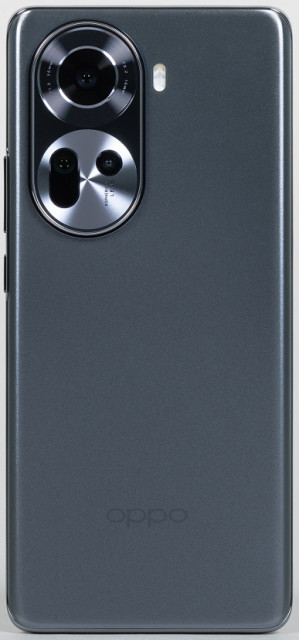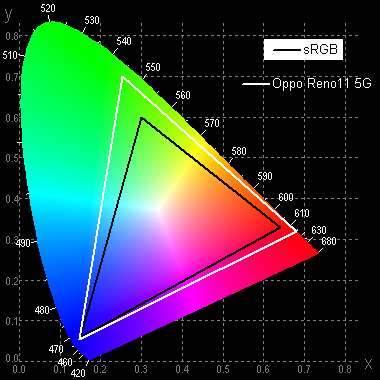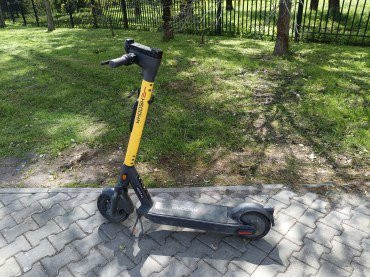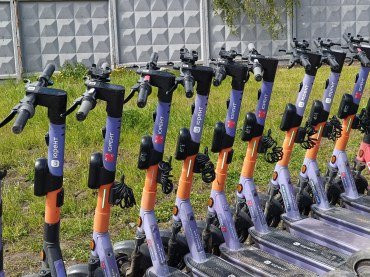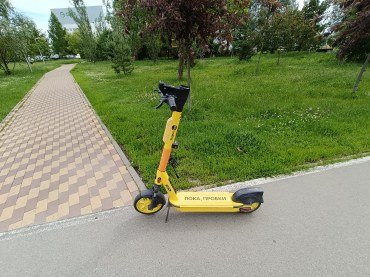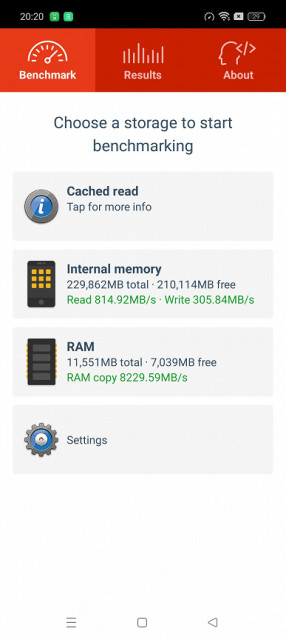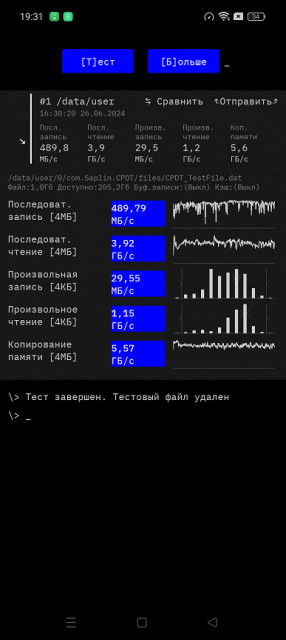The new smartphone in the Oppo Reno main line is aimed at users who are looking for a balanced choice, not wanting to overpay for flagship devices, but also not ready to compromise with budget models due to their limited photography capabilities. The Oppo Reno11 5G is a mid-range smartphone positioned as a sub-flagship tier with cameras including a telephoto lens for optical zoom.

Key Features of Oppo Reno11 5G (Model CPH2599)
- SoC Mediatek Dimensity 7050, 8 processor cores (4×Cortex-A78 @2.2 GHz + 4×Cortex-A55 @1.8 GHz)
- GPU Mali-G68 MC4
- Operating system Android 14, ColorOS 14
- Touch display AMOLED, 6.7″, 1080×2412, 20:9, 394 ppi, 120 Hz
- RAM 8/12 GB, internal memory 256 GB
- microSD support (combined slot)
- Nano-SIM support (2 pcs.)
- Networks 2G GSM, 3G WCDMA, 4G LTE, 5G
- GPS, Glonass, BDS, Galileo
- WiFi 6
- Bluetooth 5.3, A2DP, LE, aptX HD, LHDC
- NFC
- IR port
- USB 2.0 Type-C, USB OTG
- There is no 3.5mm audio output for headphones
- Cameras 50 MP + 32 MP (long-focus) + 8 MP (wide-angle), video 4K@30 fps
- Front camera 32 MP
- Proximity and lighting sensors, magnetic field, accelerometer, gyroscope
- Fingerprint scanner (under the screen)
- Battery 5000 mAh, charging 67 W
- Dimensions 162×74×7.9 mm
- Weight 182 g
Appearance and ease of use
The Oppo Reno11 5G smartphone comes in a hard cardboard package with a discreet, laconic design.

The kit includes a 67 W power supply, connecting cable and protective case

The Oppo Reno11 5G has a streamlined design with curved panels and tapered sides. This is a solution where practicality is sacrificed in the name of beauty. The smartphone looks thinner than it actually is, but in the hand it slides and scrolls like a bar of soap due to the lack of pronounced side edges and rounded shapes. The waterfall screen gives the device a dramatic look, but its glare can distort colors.

I repeat: visually the device does not cause any complaints. Oppo Reno11 5G looks sophisticated, elegant and expensive. However, not all materials can be called premium: the side frame, although shiny in the light, is made of metallized plastic, which can lose its original appearance over time. Considering the price of the smartphone, it would be quite possible to use real metal for the frame.

The manufacturer does not say what the back is made of, but it looks like frosted glass. But the front glass has been identified: it is Asahi Glass AGC DT-Star2 with curved edges.
Smartphone cameras are designed in an unusual way. All BBK devices obviously follow general guidelines, maintaining a variety of goodies on the back of their phones. Instead of combining cameras into one unit, as Apple, Samsung, and even Tecno and Infinix do, BBK prefers to keep each camera individual.

The camera block protrudes, which lifts the phone when it's lying on a flat surface, causing it to wobble a bit when using the screen. However, the angled positioning of the cameras allows you to avoid your fingers blocking them while shooting, which is a more important aspect.

The included case is questionable. While it looks more expensive than regular clear silicone cases, the opaque design completely hides the entire look of the case that the designers worked so hard to create.

The side buttons themselves are very thin, matching the frame. They are located on one side, right under the finger, and have a fairly elastic movement.

A single front camera eye is installed behind a circular cutout in the screen matrix in the center of the top edge.

The fingerprint scanner is located under the bottom of the screen glass. The sensor is optical, located low, this solution is less convenient and less fast than the scanner in the side button.

In the tray at the bottom end you can install two Nano-SIM cards (on one and the other side of the slide). It is also possible to install a microSD memory card in one of the slots instead of a SIM card. This is no longer so common among modern devices.

Here at the bottom end there is a speaker, microphone and USB Type-C connector.

The top end is given over to an additional microphone and a second speaker for stereo sound, and there is also an IR transmitter.

The Oppo Reno11 5G comes in two primary colors — green and grey. The case has not received certified protection against moisture and dust.
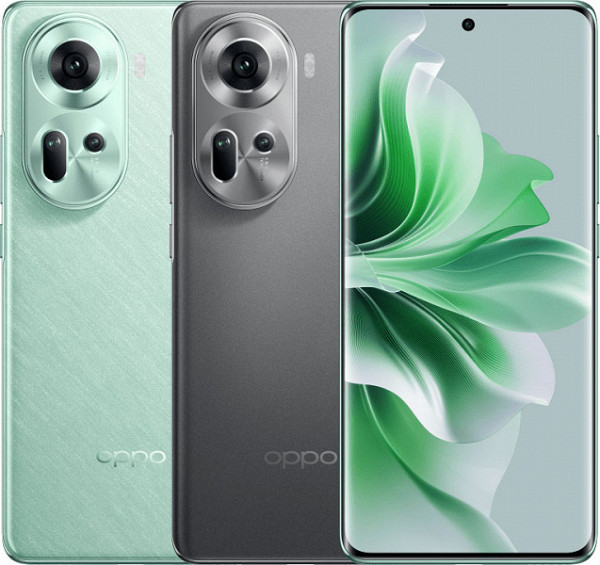
Screen
The Oppo Reno11 5G smartphone is equipped with a 6.7-inch diagonal AMOLED display with a resolution of 1080×2412 (20:9), protected by curved glass. The physical dimensions of the screen are 70x156 mm, pixel density is 394 ppi. The width of the frame around the screen is 2 mm on the sides and 3 mm on the top and bottom. The screen supports a 120Hz refresh rate.
The front surface of the screen is made of a glass plate with a mirror-smooth surface that is scratch-resistant. The reflections of objects on the screen are slightly less than on the Nexus 7, thanks to improved anti-glare properties. An effective oleophobic coating is applied to the outer surface of the screen, which makes it easier to remove fingerprints and slows down their formation compared to regular glass.
The maximum screen brightness when displaying a white field in full screen is about 480 cd/m² and can reach 775 cd/m² in bright light, which is a very high value. The actual brightness of white areas may be higher than the specified values if there is less white area on the screen. The screen has a minimum brightness value of 2 cd/m², which allows you to comfortably use the device in complete darkness.
The automatic brightness adjustment function is powered by a light sensor located under the screen. Depending on external conditions, the screen brightness is automatically adjusted and can be configured by the user. For example, in complete darkness the brightness is automatically reduced to 7 cd/m², which may seem a bit dark; in office environments it is set to 100 cd/m², and in bright light (comparable to direct sunlight) it reaches a maximum of 775 cd/m².
At medium and high brightness levels there is significant modulation at around 60, 90 or 120 Hz.

At high and medium brightness levels, the modulation duty cycle is low, eliminating visible flicker, despite the low frequency of 60 Hz. When the brightness is significantly reduced, modulation appears with a high fundamental frequency (2160 Hz), but visible flicker remains unnoticeable.
A mode with an increased refresh rate of up to 120 Hz is available in the screen settings, which can be enabled for a smoother display of content.

In 120 Hz mode, scrolling through menu lists is noticeably smoother. Let's see if this changes the nature of the modulation:

At high and medium brightness, the modulation frequency has doubled, but there is still no visible flicker. At low brightness, the modulation character remained the same — there was no flickering either. In the settings of each application, you can limit the maximum screen refresh rate to 60, 90 or 120 Hz.

Modulation at 90 Hz:

As expected, the modulation frequency is 90 Hz at high and medium brightness, and 2160 Hz at low brightness, with no visible flicker.
This screen uses a Super AMOLED panel based on active matrix organic light-emitting diodes. A full-color image is formed using subpixels of three colors — red ®, green (G) and blue (B), while the number of red and blue subpixels is half as much, which can be designated as RGBG. This is confirmed by a fragment of a microphotograph.
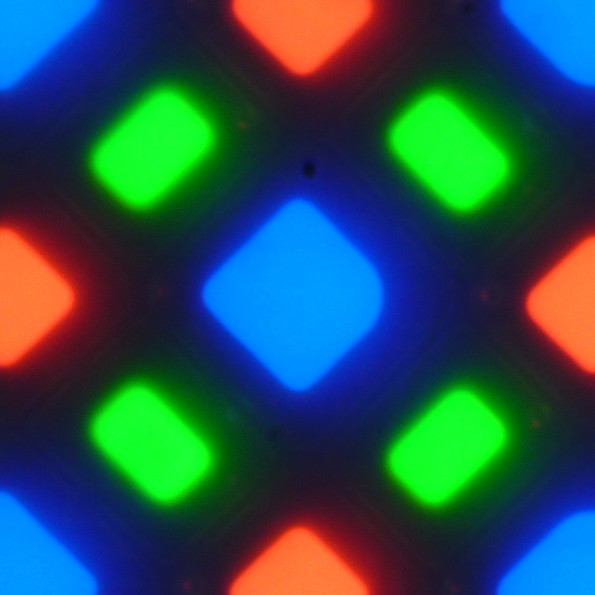
In the fragment above you can count 4 green subpixels, 2 red (4 halves) and 2 blue (1 whole and 4 quarters), which allows you to evenly cover the entire screen without breaks or overlaps. Samsung calls such matrices PenTile RGBG. Screen resolution is determined by green subpixels, so it will be lower for red and blue ones. This may introduce small artifacts such as jagged contrast edges, but due to the high resolution the impact is minimal.
The screen has excellent viewing angles. Brightness decreases at an angle, but for a smartphone this drop is less pronounced, so at the same brightness the smartphone screen appears visually brighter compared to LCD screens. At large angles, white can take on a slightly noticeable blue-green tint, while black remains completely black at all angles, making the contrast setting unusable. For comparison, the photographs below show the screens of a smartphone and a second device with the same images. The brightness of both screens is set at around 200 cd/m², and the camera's color balance is forced to 6500 K.
There is a white field perpendicular to the screens:

We note good uniformity of brightness and color tone of the white field, with the exception of barely noticeable darkening and changes in hue at the curved edges.
And a test picture:

The colors on the smartphone screen are oversaturated (note the tomatoes, bananas, napkin and face shade), and the color balance is noticeably different. Let us remind you that the photograph is not a reliable source of information about the quality of color rendition and is provided for illustrative purposes only. For example, the pronounced reddish tint of white and gray fields present in photographs of a smartphone screen is visually absent when viewed from a perpendicular view, as confirmed by hardware tests with a spectrophotometer. This is due to the fact that the spectral sensitivity of the camera matrix does not coincide with the characteristics of human vision.
Note that the image on the screen occupies the entire available area and extends onto the curved edges, which leads to slight darkening and color distortion. In the light, these areas often reflect glare, making it difficult to view images in full screen. Even movies with an aspect ratio of 16:9 are crooked, making it difficult to watch.
The photo above was taken with the «Vivid Colors» profile in the screen settings, which is selected by default. There are two profiles in total:

When choosing the Natural profile profile, the situation is better:

Color saturation is normal, no increase in color contrast is observed.
Switching the state of the matrix elements occurs almost instantly, but at the turn-on edge there may be a step with a width of about 17 ms (which corresponds to a screen refresh rate of about 60 Hz), or about 11 ms (90 Hz), or about 8 ms (120 Hz). For example, this is what the dependence of brightness on time looks like when moving from black to white:

Under some conditions, the presence of such a step can lead to the appearance of plumes trailing behind moving objects.
A gamma curve constructed using 32 points with equal intervals in gray value showed that there were no significant deviations in either highlights or shadows. The power function fit exponent is 2.27, which is slightly higher than the standard value of 2.2, so the image is slightly darkened. In this case, the real gamma curve deviates little from the power-law dependence:

Let us recall that in the case of OLED screens, the brightness of image fragments dynamically changes depending on the nature of the displayed image — it decreases slightly for generally bright images. Therefore, the resulting dependence of brightness on hue (gamma curve) may not exactly correspond to the gamma curve of a static image, since the measurements were carried out with sequential output of shades of gray almost over the entire screen.
The color gamut in Vivid Colors mode is wider than sRGB and very close to DCI-P3:
When you select the Natural gamut profile, it is compressed to the sRGB boundaries:

In the case of Vivid Color profiles, the spectra of the components are very well separated, which allows for a wide coverage:

In the case of the Natural profile with maximum coverage correction, the color components are mixed together to a significant extent:

Note that on wide-gamut screens without appropriate color correction, regular images optimized for sRGB devices appear unnaturally saturated. Therefore, it is recommended in most cases to select the “Natural” profile for watching movies, photos and everything natural. The «Vivid Colors» profile is suitable for materials with DCI-P3 coverage, used in digital cinema, but rarely found in everyday life.
The balance of shades on the gray scale in the “Natural” profile is acceptable — the color temperature is not much higher than the standard 6500 K and changes little over a significant portion of the gray scale, which improves the visual perception of color balance. The deviation from the blackbody spectrum (ΔE) is below 10 units, which is considered a good indicator for a consumer device, and the spread of this characteristic is also not very large:
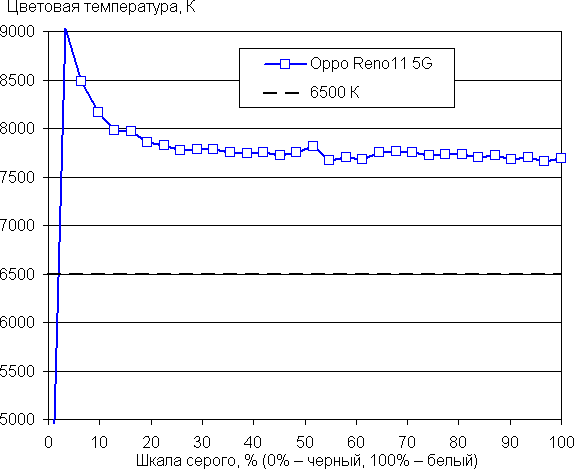
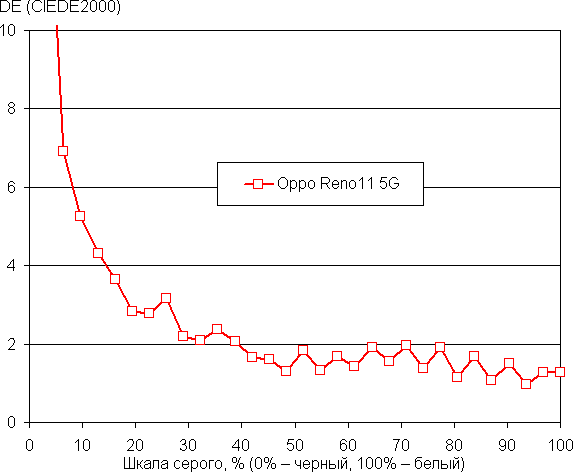
(The darkest areas of the gray scale can be ignored in most cases, since color balance there is not very important, and the error in measuring color characteristics at low brightness is high.)
In this device, you can adjust the color balance by adjusting the tone from cool to warm. However, changing this slider resets the color gamut correction to the same as in the Vivid Colors profile. Therefore, for more correct color reproduction, it is recommended to simply select the “Natural” profile, since natural saturation is more important than precise color balance.
You can also reduce the intensity of the blue component in the settings.

In principle, bright light can disrupt the circadian rhythm, but this can easily be resolved by reducing the brightness to a comfortable level, without the need to distort the color balance by reducing the blue component.
The device probably doesn't support DisplayPort Alt Mode for USB Type-C, which means it won't be able to output video and audio to an external device via the USB port.
To summarize, the screen has a very high maximum brightness of up to 775 cd/m² and excellent anti-glare properties, which allows you to use the device even outdoors on a bright sunny day. In complete darkness, the brightness can be reduced to a comfortable 2 cd/m². The automatic brightness adjustment mode works adequately. Among the advantages of the screen are an effective oleophobic coating, no visible flicker, support for a high refresh rate of up to 120 Hz and a color gamut close to sRGB when choosing the right profile. The advantages of OLED screens include true black color, good uniformity of the white field and less drop in brightness when viewed at an angle compared to LCD.
However, it's worth noting that curved screen edges can affect image quality by introducing color distortion and reducing brightness at the edges of the picture, especially in ambient light, which can cause glare along the long side of the screen. Overall, the image quality on the screen is very high.
Camera
The Oppo Reno11 5G smartphone is equipped with four cameras: three rear and one front:
- Main camera: 50 MP, 1/1.95″, f/1.8, 26 mm, PDAF, OIS. By default, photos are captured at 12.5MP resolution using 4-in-1 pixel binning, but shooting at full 50MP resolution is also possible.
- Telephoto: 32 MP, 1/2.74″, 0.8 µm, f/2.0, 47 mm, PDAF, 2× optical zoom.
- Wide-angle: 8 MP, 1/4.0″, 1.12 µm, f/2.2, 16 mm, 112˚.
- Front camera: 32 MP, 1/2.74″, 0.8 µm, f/2.4, 22 mm.
The main camera uses a Sony LYT600 sensor and can shoot at full 50MP resolution, but 50MP photos often suffer from heavy processing, resulting in distortion and suboptimal image quality when viewed at full size. In this mode, only a slight gain in detail is achieved due to the high resolution of the physical image.
If you don’t pay attention to the 50 megapixel mode as a bad dream and shoot in 12.5 megapixels, then the photo quality is generally good, although not at the level of flagship models. The images are clean, but the detail is not the highest, blurring around the edges and excessive contour sharpness are especially noticeable. Good contrast is positively noted, which gives the pictures richness and volume. There are no highlights or strong shadow blockages observed. Color reproduction is not always natural, but it is possible to customize using color filters to achieve the desired result.
Examples of pictures taken with the main camera in automatic mode can be seen below:
The camera copes well with portrait photography: it does not overload the image with small details at this focal length and achieves good results. However, the background blur algorithm looks quite low-cost.
Night shots are subject to very aggressive processing: after dealing with noise and adding contour sharpness, the details are simply lost. However, the exposure remains adequate, the pictures retain the night atmosphere and are not overexposed, so they are quite suitable as miniatures.

A separate module with a Sony IMX709 sensor implements an honest 2× optical zoom. The maximum zoom is 20×, but this is already a hybrid and pure digital zoom. As with the main camera, photos are displayed in full size (32 megapixels) and in pixel binning mode (8 megapixels).
Here the situation with processing full-size images is better: the emphasis on contour sharpness is noticeable, but still tolerable. However, the fight against noise occurs with varying degrees of success: some areas of the frame are left “as is”, others are “cleaned up”. But with the reduced-scale photographs, everything is just bad: the original is significantly cropped (although the corners of the 32-megapixel photographs seem to be quite adequate), it is hellishly sharp and free of even a hint of detail after noise removal. Well, really, the contrast is good and the richness is high.
There’s not much to say about the wide-angle module with the Sony IMX355 sensor; the quality is at a basic level: detail is low, the edges of the frame are blurred, sharpening has reached here too. The pictures are darkish and have a loose image.
The maximum video shooting mode reaches 4K at 30 frames per second. To achieve 60 frames per second, you will have to reduce the resolution to 1080p and partially sacrifice detail. The image is bright, but without stabilization in 4K mode, video footage can jerk, and turning on stabilization degrades the picture, making it less clear.
Telephone and communications
The Oppo Reno11 5G smartphone supports a wide range of mobile networks, including 5G, as well as both Wi-Fi 6 and Bluetooth 5.3 bands, as well as NFC. However, it does not support e-SIM. In urban conditions of the Moscow region, the device demonstrates stable operation in wireless networks, without losing connections and quickly restoring it after a break. All built-in sensors, including a gyroscope, are present.
The single-channel satellite navigation module supports GPS, Glonass, BDS, Galileo and QZSS. The initial detection of satellites during a cold start occurs quickly, and the positioning accuracy is high.
The volume of the speaker is sufficient, the voice of the interlocutor is clearly audible. The vibration when calling is pleasant and soft, although not too strong.
Software and multimedia
The Oppo Reno11 5G smartphone runs on Android 14 OS with ColorOS 14 shell. The interface is mostly typical for Chinese shells, but there are several features. First, there's an intrusive layer that claims to be a virus scanner but is actually used to serve ads, reminiscent of Xiaomi and Vivo's approach. This is perceived negatively by users due to commercial pressure. Secondly, many pre-installed applications are grouped into folders on the screens, which has already become standard practice for Vivo.
However, there are positive aspects: the notification curtain and quick settings are presented in a single section, which is convenient. Also, access to the official Google Play application store and Google services is provided without problems.
The audio system of the Oppo Reno11 5G smartphone produces bright and fairly loud sound, but not rich enough, with a predominance of high frequencies. For wireless headphones, aptX HD and LHDC codecs are supported.
Performance
The Oppo Reno11 5G smartphone is powered by an octa-core Mediatek Dimensity 7050 processor and Mali-G68 MC4 GPU. RAM is 8 or 12 GB LPDDR4x, and built-in storage is 256 GB UFS 2.2. It is possible to expand the memory via a memory card, but this is at the expense of the second SIM card. USB OTG is supported for connecting external devices via the USB Type-C port.
The platform is relatively new, released on May 2, 2023 on a 6-nanometer process technology. In the AnTuTu benchmark, the device scores about 500 thousand points, which corresponds to an average level of performance with minimal throttling. This is enough for everyday tasks and smooth operation of the interface, but not for recording 4K video at 60 fps. The device also copes with games, but not at maximum settings.
Testing in comprehensive tests AnTuTu and GeekBench:
We compiled all the results obtained when testing the smartphone in the latest versions of popular benchmarks into tables for easy comparison. Typically, the table also includes results from other devices from different segments that passed the same tests on similar versions of benchmarks. This helps to visually evaluate the obtained figures. However, due to limitations of comparison within a single test, not all worthy and relevant models are included in the table due to differences in test program versions.
| Oppo Reno11 5G (MediaTek Dimensity 7050) | Vivo V30e (Qualcomm Snapdragon 6 Gen1) | Infinix Note 40 (Mediatek Helio G99 Ultimate) | Huawei Nova 12s (Qualcomm Snapdragon 778G) | Redmi Note 13 Pro+ (Mediatek Dimensity 7200 Ultra) | |
|---|---|---|---|---|---|
| AnTuTu (v9.x) (bigger is better) | 509328 | 489575 | 388230 | 546957 | 669583 |
| GeekBench 6 (bigger is better) | 1091/2571 | 939/2871 | 738/2025 | 996/2453 | 1126/2643 |
Testing the graphics subsystem in GFXBenchmark gaming tests:
| Oppo Reno11 5G (MediaTek Dimensity 7050) | Vivo V30e (Qualcomm Snapdragon 6 Gen1) | Infinix Note 40 (Mediatek Helio G99 Ultimate) | Huawei Nova 12s (Qualcomm Snapdragon 778G) | Redmi Note 13 Pro+ (Mediatek Dimensity 7200 Ultra) | |
|---|---|---|---|---|---|
| GFXBenchmark Aztec Ruins OpenGL (Onscreen, fps) | thirty | 29 | 18 | 34 | 50 |
| GFXBenchmark Aztec Ruins Vulkan (Onscreen, fps) | 26 | 31 | 16 | 38 | 55 |
| GFXBenchmark Car Chase ES 3.1 (1080p Offscreen, fps) | 26 | 24 | 17 | 33 | 43 |
| GFXBenchmark Manhattan ES 3.1 (1080p Offscreen, fps) | 45 | 45 | 28 | 56 | 74 |
| GFXBenchmark T-Rex (1080p Offscreen, fps) | 106 | 106 | 67 | 133 | 191 |
Testing in browser cross-platform tests:
| Oppo Reno11 5G (MediaTek Dimensity 7050) | Vivo V30e (Qualcomm Snapdragon 6 Gen1) | Infinix Note 40 (Mediatek Helio G99 Ultimate) | Huawei Nova 12s (Qualcomm Snapdragon 778G) | Redmi Note 13 Pro+ (Mediatek Dimensity 7200 Ultra) | |
|---|---|---|---|---|---|
| Google Octane 2 (bigger is better) | 7118 | 33442 | 24041 | 24923 | 39276 |
| JetStream (bigger is better) | 29 | 93 | 76 | 67 | 79 |
Memory speed test results:
Heat
We test for performance degradation when heating using the Burnout Benchmark program, which allows you to load the CPU, GPU and NPU:
| Stress on | Heating performance, as a percentage of maximum |
|---|---|
| CPU | 65% |
| GPU | 67% |
| NPU | 92% |
Battery life
The Oppo Reno11 5G smartphone is equipped with a battery with a modern standard capacity of 5000 mAh, which provides a high level of autonomy by modern standards.
Testing was conducted at normal power consumption levels without activating power-saving features, although such features are available on the device. Test conditions included a minimum comfortable level of screen brightness (approximately 100 cd/m²). The tests used the following scenarios: continuous reading in the Moon+ Reader application using the standard light theme, continuous viewing of video in HD quality (720p) and the game Injustice 2 with automatic graphics settings.
| Battery capacity | Reading mode | Video mode | 3D gaming mode | |
|---|---|---|---|---|
| Oppo Reno11 5G | 5000 mAh | 27:00 | 25:00 p.m. | 8:00 a.m. |
| Vivo V30e | 5500 mAh | 29 h 00 m | 26 h 00 m | 8:00 a.m. |
| Infinix Note 40 | 5000 mAh | 18:30 | 15:00 | 6 h 30 min |
| Tecno Spark 20 Pro+ | 5000 mAh | 18:00 | 14:00 | 6:00 a.m. |
| Vivo V30 | 5000 mAh | 23:00 | 21:00 | 8:00 a.m. |
| Vivo V29 | 4600 mAh | 21:00 | 19:00 | 8 h 30 min |
| Infinix GT 10 Pro | 5000 mAh | 20:30 h. | 18:00 | 8 h 30 min |
All specifications shown represent the maximum possible results achieved under «ideal» testing conditions, including no SIM cards installed. Any changes in conditions of use will likely result in a deterioration in these results.
The smartphone charges from the supplied mains charger in 45 minutes. Wireless charging is not supported.
Bottom line
In official retail Oppo Reno11 5G is offered for $350. This smartphone is a typical representative of the mid-segment, not reaching the level of a sub-flagship. All its characteristics and capabilities are at an average level, the only things that stand out are its attractive design, which can be called “flagship” (although its practicality is questionable), as well as its high autonomy.
However, it is very strange that with such a positioning (as “still inexpensive, but with cameras almost like flagships”), the photo and video capabilities of the smartphone are not impressive. Despite the presence of three rear cameras, the quality of photography is mediocre, and the optical zoom (2×) only compensates for the unsatisfactory full-size mode of the main camera. This puts it at a disadvantage compared to other near-budget models that offer decent zoom up to 2-3x. Additionally, the lack of 4K 60fps video capability is surprising.


